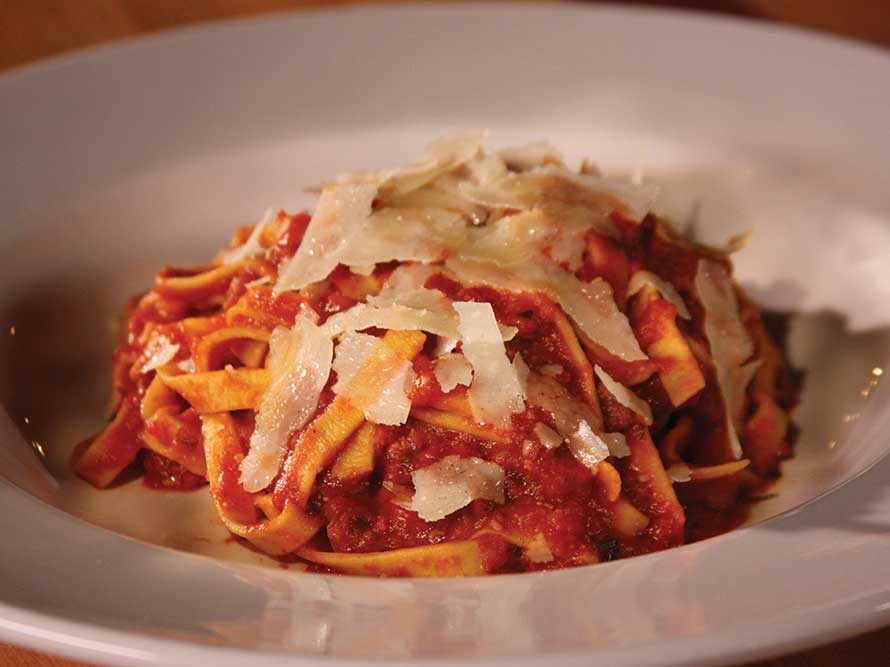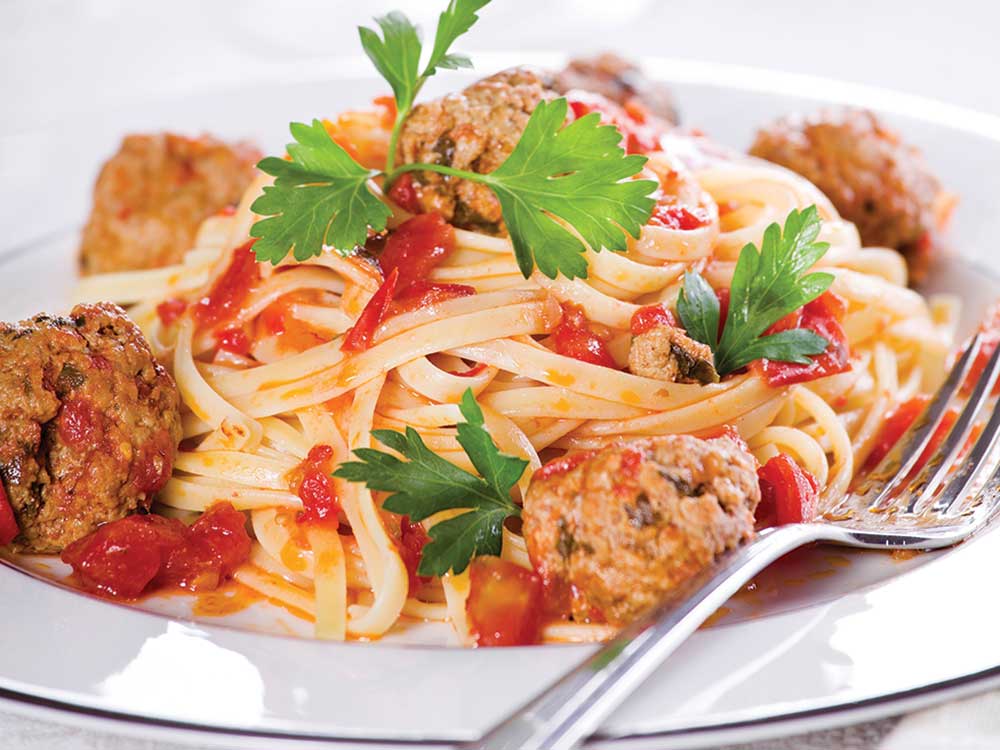Nothing beats a hot slice of pizza fresh from the oven, which is why so many pizzerias offer nothing but pies. But when operators incorporate entreés into the menu, many of them can effortlessly increase customer visits and profits without boosting overhead costs. “We are probably 85% pizza to 15% Italian-type pastas/appetizers,” says Jay Jerrier, owner of Cane Rosso (cannerosso.com) and Zoli’s NY Pizza (zolispizza.com) in Dallas. “People come to us for pizza, but having other Italian entreés encourages them to eat with us multiple times per week.”
Think about it for a moment: You already have most of what you need to offer a multitude of Italian entreés and appetizers—except for possibly pasta, which is easy to find (and cheap). When your customers—or their eating companions—are in the mood for something other than their favorite slice, you can be the one to feed their hunger. Some of the more popular entreés, which are easy to add to the menu using what you already have in-house (plus pasta), include: spaghetti and meatballs; lasagna; chicken Alfredo; chicken Parmesan; baked ziti; ravioli; and pasta primavera.

pasta amatriciana |
| recipe courtesy of Cane Rosso
5 oz. pasta (your choice of bucatini, linguine or tagliatelle) Extra-virgin olive oil to coat pan 2 oz. diced pancetta (thick-cut, diced bacon will also work) 1 oz. red onion, diced 5 oz. red sauce (for best results, crush one 28-oz. can of Italian plum tomatoes or San Marzano tomatoes with the back of a fork until they are mashed but still chunky. You can also use a simple jarred tomatoeso/basil sauce) 2 tbsp. Parmigiano and Pecorino cheeses, grated 1 tbsp. red pepper flakes, crushed
Note: Have a pot of boiling salted water ready for the pasta going before starting this dish. You will not cook the pasta all the way; you will finish it in the pan with the sauce. Drop the pasta into the boiling water to start the cooking process. Meanwhile, in a sauté pan, heat the oil over high heat and add pancetta. Saute until the pancetta is rendered (when most of the fat melts away) and turn the heat down to medium. (The pancetta should look like crispy bacon.) Add onions and stir constantly, making sure the onions do not burn. Once the onions are soft and cooked through, add sauce. Cook for 1 minute and add cheese and pepper flakes, stirring to incorporate. Turn off the heat on the sauce and add the cooked pasta to the sauté pan with the sauce. Turn the heat back to low on the sauté pan and toss the pasta constantly so that the sauce will “stick” to the pasta (the sauce should be thick and shouldn’t create a pool on the plate). Transfer the pasta and sauce to a bowl and sprinkle more cheese on top to serve. |
Incorporate With Ease
“The entrées that are easiest to incorporate, most cost-effective, profitable and most popular are right at our fingertips,” says Alex Rubeo, co-owner of North Salem, New York’s Two Meatballs Pizzeria (twomeatballspizza.com), which sells about 50% pizza and 50% everything else (including appetizers, salads, sandwiches and entrees). “Using ingredients in-house, instead of buying new ones, is a home run. We have tomato sauce, cheese and chicken; a sizzle plate goes into the pizza oven, and chicken Parmigiana—a top seller—emerges.”
It’s easy to create a variety of dishes, according to Rubeo. “Use different sauces with different styles of chicken—fried, sautéed, or grilled—and pair them with pasta and a hunk of bread,” he says. “You just created a $15 plate.”
“For both of our restaurants, we sell way more pizza than other entreés,” Jerrier says. “However, we try to feature a regular rotation of pastas at Cane Rosso. I think those are the easiest for a pizzeria to pull off because you can generally make a very nice pasta using the same ingredients you’d have on your pizza line: tomatoes, fresh mozzarella, zucchini, mushrooms, onions, sausage, etc. Almost anything you can put on a pizza, you can put in a pasta.”
—Alex Rubeo, Two Meatballs Pizzeria
At Cane Rosso, fresh pasta is rolled out daily using the same Italian flour used for the pizzeria’s pizza dough, but Jerrier says you can easily find a quality dry pasta for simplicity.
Often, the easiest way to determine which entrées will sell is to introduce them as specials. Pizza Nola (pizzanola.com) in New Orleans features five pasta entrées: Spaghetti & Meatballs, Fettuccine Alfredo (available with shrimp, chicken or Portobello mushrooms), Pasta Primavera, Meat or Veggie Lasagna and Shrimp Scampi, according to owner Will Samuels. Several of them started as specials. “We added the scampi as an item on a special Lent menu, and customers liked it, so we just kept it on the regular menu,” Samuels says. “The lasagnas were originally added as a special because our kitchen manager had a good recipe and wanted to test it out.”
An Easy Sell
If a customer spotted lasagna on the menu at a sushi restaurant, he’d do a double take. But Italian entreés are a natural fit for pizzerias. Many customers, in fact, expect you to offer some of their favorite Italian entrée dishes. “Specialty pastas and lasagna go hand-in-hand with pizza, although you need to be careful not to single-stock items just for a pasta,” Jerrier says. “At a pizzeria, you will always sell more pizza, so you don’t want to waste money on single-use items. Our Caprese Salad is a very popular item when tomatoes are in season, and you can also make it into a pasta dish. On weekends, we make a meatball lasagna that’s wildly popular and sells out every weekend. We roll out fresh pasta sheets for the lasagna and add heavy béchamel, housemade meatballs and sausage. It’s not for the faint of heart.”
“Spaghetti & Meatballs is our best-seller, with the Fettuccine Alfredo (usually served with chicken) coming in close behind,” Samuels says. “The Spaghetti & Meatballs are popular because we offer a large portion with huge made-in-house meatballs that are a combination of ground beef and ground turkey.” Samuels even recalls that one customer, who has since moved out of town, ordered Pizza Nola’s Meatballs & Spaghetti for delivery 140 times over a span of two years.
Cost and Profit
When considering adding or expanding an entrée menu, consider the product and labor costs involved. Overall, there should not be too many added costs; for the most part, you should have everything you need already. Mike Rasmussen, an accountant specializing in restaurants at Rasmussen Tax Group in Conway, Arkansas, reminds pizzeria operators that adding pasta to the menu should never involve any additional costs—ingredient, labor or otherwise. “If you have to hire a new employee to create the pasta dishes, that’s considered an additional cost,” says Rasmussen. “The goal here is to increase your profits while utilizing what you already have on hand.”
Oftentimes, adding pastas can even help use ingredients you may have previously tossed away as scraps. “Pastas are a great way to make sure you are using every last ingredient in-house,” says Jerrier. “You can make a great pasta with the very ends of the prosciutto or soppressata. Once it gets too small to run through the slicer, you can cut it into a medium dice and sauté/fry it, and throw it into a pasta; no waste, and it tastes great.”
Promotion Savvy
It can be easy to forget about promoting your new pasta entrées when you’re focusing on your pizza, but every item deserves its moment in the spotlight, whether it’s through mentions on social media, box toppers, blackboard specials, table tents or text and email blasts.
Jerrier uses the power of social media to promote its pasta offerings. “We take a few pictures and send the blast out,” he says. “Between our three restaurants, we have about 16,000 followers across our social media platforms, so word gets around pretty quickly.”
Although Pizza Nola has a handle on social media, an all-you-can-eat pasta night didn’t catch on as expected, Samuels notes. “I think the reason people may not be taking advantage of all-you-can-eat pasta is because our individual portions are so large. We may consider running it as a lunch special.”
And while Two Meatballs Pizzeria uses a lot of social media and blackboard specials to promote its specials, the owners also find that its entrées help promote the pizzeria to health-conscious and gluten-sensitive customers. Rubeo says that with all of the vegetables they carry for pizza, it’s easy to sauté them up, add grilled chicken or shrimp and create healthy, low-carb, gluten-free entreés. “We offer six or seven healthy entrée variations with grilled chicken and shrimp,” he says.
So whether you’re just venturing into adding entrées to your menu or your dishes already have a rabid fan following, keep your cost-to-profit ratio in check and always pay attention to the wants and needs of your customers. You should find yourself with a winning recipe for Italian entrée success!













